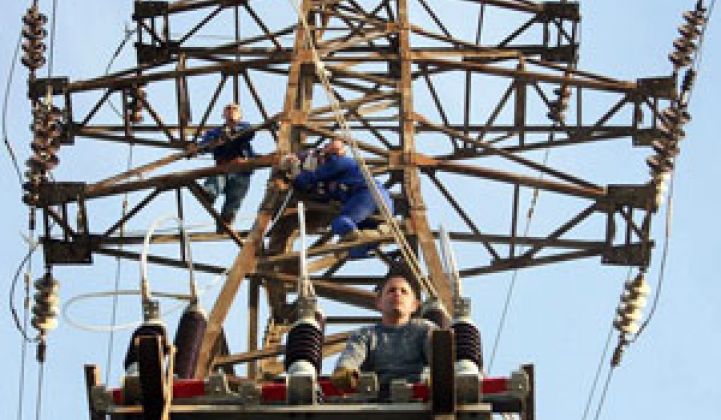There's a chicken and egg problem of sorts brewing in the smart grid investment world – which comes first, the utilities or their customers?
That problem was on the minds of some of the venture capital investors and energy management startup execs at a Tuesday talk sponsored by the SDForum at SAP Labs in Palo Alto, Calif.
Why the worry? Building an electricity distribution system that can sense, communicate and control energy usage, outages and power generation is a complicated and expensive proposition – $50 billion to $65 billion, according to the Edison Electric Institute, a utility trade group.
And the stimulus package signed into law by President Barack Obama last week contains billions of dollars in grants and other support for smart grid efforts – a clarion call to investors looking for 50-50 support from the government (see Obama Signs Stimulus Package).
The problem, however, is that utilities move slowly, and only with permission from regulatory bodies that don't always base their decisions on economic grounds.
That makes VCs nervous about securing a timely return on their investment – and eager to back startups with business plans that don't rely on utilities' glacial pace of change, said Laurie Yoler, managing director at GrowthPoint Technology Partners.
"We're seeing a lot of terrific technology and entrepreneurial ventures that are moving a lot more rapidly than the utilities are," Yoler said.
Of course, that hasn't stopped venture capitalists from investing large amounts in smart grid startups like smart meter networking providers Silver Spring Networks and Trilliant (see Silver Spring Grabs $75M and this Green Light post).
Yet despite the sea change that American utilities have undergone in deploying smart meters – the two-way communicating electric meters seen as the first step in building a smart grid – much more remains to be done, Yoler said.
The Federal Regulatory Energy Commission pegged the adoption rate of smart meters as 4.7 percent at the end of last year (see Smart Meter Installations Grow Nearly Fivefold). That may seem like a tiny number, until you take the perspective of utilities that need to ask regulatory commission to bill customers billions of dollars to put them in place, Yoler noted (see SCE Preps $1.63B Smart-Meter Program).
That means that "The opportunity to move and do something today is the opportunity to do something without utilities," said Roland Acra, CEO of San Francisco-based startup Arch Rock.
His view makes sense, given that his company is installing energy-sensor systems for commercial clients looking to save money without necessarily needing utilities to give them the thumbs-up (see A ZigBee-IP Combo for Data Centers and Smart Meters?).
But there's a big problem with pushing businesses like demand-response systems for businesses or home energy monitoring and saving devices for homeowners out ahead of utility smart meter deployments, said Matthew Denesuk, a partner with IBM Venture Capital Group.
That is, "You're going to need investment to come from somewhere, and utilities are the natural choice for that," he said.
That's a commonly shared view among observers of the less-than-stellar consumer response to various efforts to market energy saving home devices in the past.
What's needed to bring energy-saving devices and systems to mass adoption, Denesuk said, is utility investment – not only in buying equipment themselves, but offering incentives to those that do on their own.
"To get a big bang for the buck on that, you want the incentive to be lower prices for saving," he said.
Denesuk also saw a need for utilities to manage the complicated work of integrating various smart grid technologies into a system that can deliver on its promise of making the grid more efficient and reliable overall – perhaps not surprising, coming from an investor with a company seeking to define itself as a leader in that field (see For 2009, It's All About Smart Grid and Storage and IBM Snags Another Deal in Smart Grid).
Even those who liked the idea of moving ahead of utilities in smart grid-related efforts conceded that the power providers do need to have some kind of link to homes and businesses installing energy-saving systems. The question remains, will that link run through smart meters, or over another network?
While some companies are pushing for utilities to link up with energy-saving homes via existing broadband connections, that solution also faces potential obstacles, like the lack of utility control over those data connections and issues of treating all utility customers equally (see A Broadband Smart Grid?).
Meanwhile, various technologies for connecting smart meters and utilities – radio frequency mesh, powerline carrier, cellular networks – are being deployed by various utilities and their vendors (see Smart Grid: A Matter of Standards, Broadband Over Powerline Brings Smart Grid to Rural Areas and Your Electrical Meter Becomes a Cell Phone).
"Yes, VCs are concerned" about waiting for utilities to choose and deploy their preferred means of communicating with their customers, said Gerd Goette, a managing partner with Siemens Venture Capital. But "most people by now accept that we have to overcome that."
And there's another issue to be overcome, he added – determining how utilities manage the data they will collect as a result.
"As long as the utilities hold onto that data and don't share it with everybody, we're very constrained on what we can do, unless we want to spend a lot of money," Gerd noted – a stance that's held by many players in the smart grid field, including recent entrant Google (see Google Gets Into Home Energy Management).



